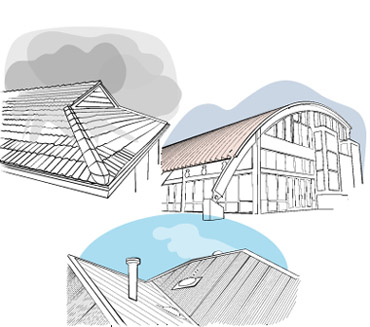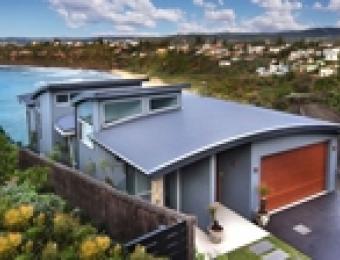
The choices you make about your roof's shape, material and colour will have implications for many other aspects of the roof too - including how much it costs, how durable it is, and how energy efficient it makes your home. Ultimately, you want a roof that looks good, lasts for a long time, doesn’t cost too much, works to reduce your heating and cooling costs, doesn’t need much maintenance and is cheap to repair. Plenty of modern roof claddings fulfil the brief on most of these counts, so striking a balance really isn't as hard as it sounds.
Following are just a few examples of what you might consider when designing and choosing materials for your roof.
Appearance
If you're sticking to a particular design theme, many of the decisions about your roof’s appearance will be simplified. In many cases, people design their roof to fit in with the rest of the house and its surroundings. For example, a hip roof made from corrugated steel will suit a standard Federation era home, whereas a Mediterranean style home might have a flat roof or one made from terracotta tiles.
Colour is used to either highlight or disguise aspects of the roof - light colours to highlight and dark ones to disguise. A light coloured roof will make your roof look bigger and vice-versa. In rural areas, roof colours can also be matched to the surrounding landscape. When choosing colours though, it's also important to know that dark colours will absorb the sun's heat, while light colours will help to reflect it.
Affordability
Some roofing materials are more expensive than others. As with most choices to do with materials, you should weigh the benefits of a more expensive roofing material against the costs. For example, slate is a premium-priced roofing material. For the price however, you get a roof that is gorgeous to look at, made from natural materials, energy efficient, and lasts a lifetime - or longer.
Asphalt shingles on the other hand are cheap and offer resistance to heat, fire and weather, but will need more maintenance and repairs than other materials. Some asphalt roofs may even contribute to ‘sick building syndrome’ if they're not properly maintained.
Energy efficiency
Your roof plays a big part in how much heat is absorbed and retained within your home, and how the climate in your house is managed. Roof colour and materials will impact on your home’s energy efficiency, particularly if you live in a warm climate. A light coloured roof made from or coated in a material that reflects energy from the sun will help to keep your home cool in hot weather. Strategically placed vents will draw cool air into your roof and encourage warm air to exit.
To design an energy efficient home you need to consider how climate control will work throughout the house - a roof is just one aspect of an energy efficient home, even if it is a particularly important one.
Local requirements and climate
Before building, it's vital that you check with your local council about whether there are any roof-related building regulations or recommendations for homes in your area. Homes built in bushfire and/or cyclone prone regions need to incorporate certain features into their roofs (such as leaf guards for gutters) to help keep houses and residents safe.
If you live in an alpine region or one that experiences heavy rainfall, the pitch of your roof will need to be steeper to encourage rain and snow to slide off. Roof pitch will also affect how your roof holds up in the face of strong winds. To get some ideas, drive around the neighbourhood and have a look at what sort of roofs other people with similar houses are using.
There may even be restrictions on colour or materials in your area. Some councils limit the colours you can choose to use, in order to help maintain the overall look and feel of the neighbourhood.
The bottom line
A house's roof will often be dictated simply by the type of house you're building, and choosing a roof is rarely as difficult as it sounds. The vast majority of houses in Australia use either steel roofing, terracotta tiles or concrete tiles - although there's nothing to stop you considering other options if you're after a different look or effect. Your architect or builder will be able to advise you further on issues like suitability, energy efficiency and price.





